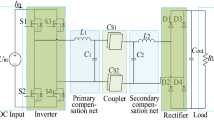Abstract
In order to solve the problems of frequency splitting and low efficiency in wireless power transfer system, the capacitive coupled wireless power transfer system with double-side LCLC compensation topology is taken as the research object in this paper. The effect laws of variable parameters on the system output are analyzed by system modeling. The relationship between system efficiency and the important parameters is derived by the using circuit theory, and the system efficiency is analyzed in detail by using MATLAB simulation software. The experiment of wireless power transfer with electronic components is conducted in this paper. The existence of frequency splitting and frequency offset is proved by experiments, and the influence of frequency and coupling capacitance on the output efficiency of the system is verified. The results show that the frequency splitting of the system can be avoided by adjusting the capacitance of the coupling mechanism below the frequency split point. Fixing the relative position of the coupling plates, the system efficiency can be improved by increasing the frequency of the system to the efficiency key point.










Similar content being viewed by others
Availability of data and materials
Not applicable.
References
Xue M, Yang Q, Zhang P, Guo J, Li Y et al (2021) Application status and key issues of wireless power transmission technology. Trans China Electrotech Soc 36(08):1547–1568
Liao ZJ, Sun Y, Xia C et al (2019) A methodology to achieve the maximum transfer efficiency for magnetic coupling wireless power transfer systems. Electr Eng 101:1177–1188
Lu F, Zhang H, Hofmann H et al (2015) A double-sided LCLC-compensated capacitive power transfer system for electric vehicle charging. IEEE Trans Power Electron 30(11):6011–6014
Zhang Z, Pang H, Georgiadis A, Cecati C (2019) Wireless power transfer—an overview. IEEE Trans Industr Electron 66(2):1044–1058
Shehata EG (2022) Design of high efficiency low frequency wireless power transfer system for electric vehicle charging. Electr Eng 104:1797–1809
Hui SY (2013) Planar wireless charging technology for portable electronic products and Qi. Proc IEEE 101(6):1290–1301
Zhang Z, Zhang B (2020) Omnidirectional and efficient wireless power transfer system for logistic robots. IEEE Access 8:13683–13693
Zeng Y, Qiu D, Meng X, Zhang B, Tang SC (2018) Optimized design of coils for wireless power transfer in implanted medical devices. IEEE J Electromagn RF Microwav Med Biol 2(4):277–285
Cheng C et al (2019) Load-independent wireless power transfer system for multiple loads over a long distance. IEEE Trans Power Electron 34(9):9279–9288
Huang J, Zhou Y, Ning Z, Gharavi H (2019) Wireless power transfer and energy harvesting: current status and future prospects. IEEE Wirel Commun 26(4):163–169
Huang R, Zhang B, Qiu D, Zhang Y (2014) Frequency splitting phenomena of magnetic resonant coupling wireless power transfer. IEEE Trans Magn 11(50):1–4
Liao Z, Ma S, Feng Q, Xia C, Yu D (2021) Frequency splitting elimination and utilization in magnetic coupling wireless power transfer systems. IEEE Trans Circuits Syst I Regul Pap 68(2):929–939
Li Y, Yin J, Yang Q, Xue M, Liu Z, Zhang X (2018) Influence of internal resistance and quality factor on transfer power and efficiency and frequency splitting. Trans China Electrotech Soc 33(12):2742–2750
Li F, Niu W (2013) Bode frequency analysis for frequency splitting phenomena of symmetrical series-tuned contactless power transfer systems. J Shanghai Marit Univ 34(1):90–94
Lan Y, Gong L, Cai X, Li H (2016) Analysis of frequency characteristics of magnetic coupled resonant wireless power transmission system. Ind Mine Autom 42(5):71–74
Zhang Y, Zhao Z, Chen K (2013) Frequency splitting analysis of magnetically-coupled resonant wireless power transfer. In: IEEE energy conversion congress and exposition, pp 2227–2232
Liu X, Ma D, Tang H (2014) Characteristic analysis of frequency model of wireless power transfer var magnetic resonant coupling. Power Electron 48(11):1–2
Xia J, Wang D, Xu D (2022) A hybrid frequency adjusting method for the wireless power transfer system. Electr Eng 104:2679–2688
Zhang Y, Zhao Z, Chen K (2014) Frequency-splitting analysis of four-coil resonant wireless power transfer. IEEE Trans Ind Appl 50(4):2436–2445
Liu S, Shen Y, Wu Y, Lin J, and Hu M (2018) Study on frequency tracking for wireless power transfer system using magnetic resonant coupling. In: 13th IEEE conference on industrial electronics and applications (ICIEA), pp 2569–2572
Nguyen H, Agbinya J (2015) Splitting frequency diversity in wireless power transmission. IEEE Trans Power Electron 30(11):6088–6096
Yang R, Sun Y, Yu J, Sun Y, Zhang M (2021) Analysis of capacitive power transfer system with LCLC compensation network. J Phys Soc Jpn 90(3):034802
Funding
The research leading to these results received funding from [the National Natural Science Foundation of China] under Grant Agreement No. [U1804143].
Author information
Authors and Affiliations
Contributions
ZW, the main finisher of the thesis, the corresponding author, is responsible for the writing of the research article, theoretical research and experimental operation. YS, co-author of the paper, is mainly responsible for the guidance of the content of the paper. RY, co-author of the thesis, is mainly responsible for the improvement and modification of the language of the thesis. MZ, co-author of the paper, is mainly responsible for the review and correction of the content of the paper. All authors read and approved the final manuscript.
Corresponding author
Ethics declarations
Conflict of interest
The authors have no competing interests to declare that are relevant to the content of this article.
Ethical approval
Not applicable.
Additional information
Publisher's Note
Springer Nature remains neutral with regard to jurisdictional claims in published maps and institutional affiliations.
Rights and permissions
Springer Nature or its licensor (e.g. a society or other partner) holds exclusive rights to this article under a publishing agreement with the author(s) or other rightsholder(s); author self-archiving of the accepted manuscript version of this article is solely governed by the terms of such publishing agreement and applicable law.
About this article
Cite this article
Wang, Z., Sun, Y., Yang, R. et al. Frequency splitting characteristics analysis of capacitive wireless power transfer. Electr Eng 105, 1299–1305 (2023). https://doi.org/10.1007/s00202-023-01732-7
Received:
Accepted:
Published:
Issue Date:
DOI: https://doi.org/10.1007/s00202-023-01732-7




